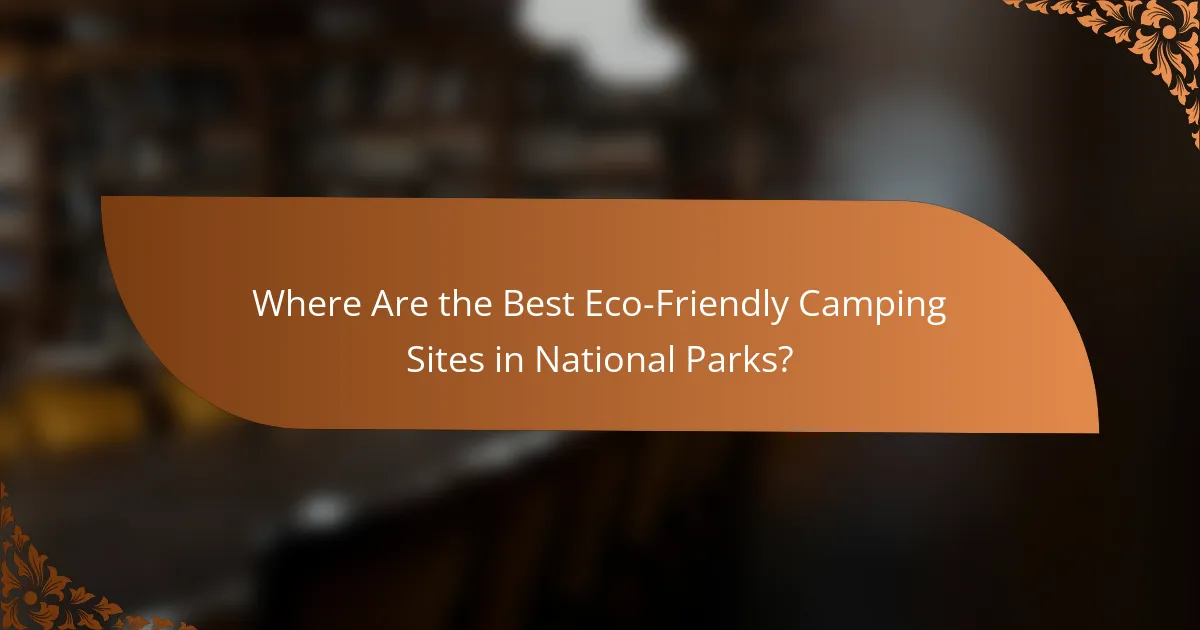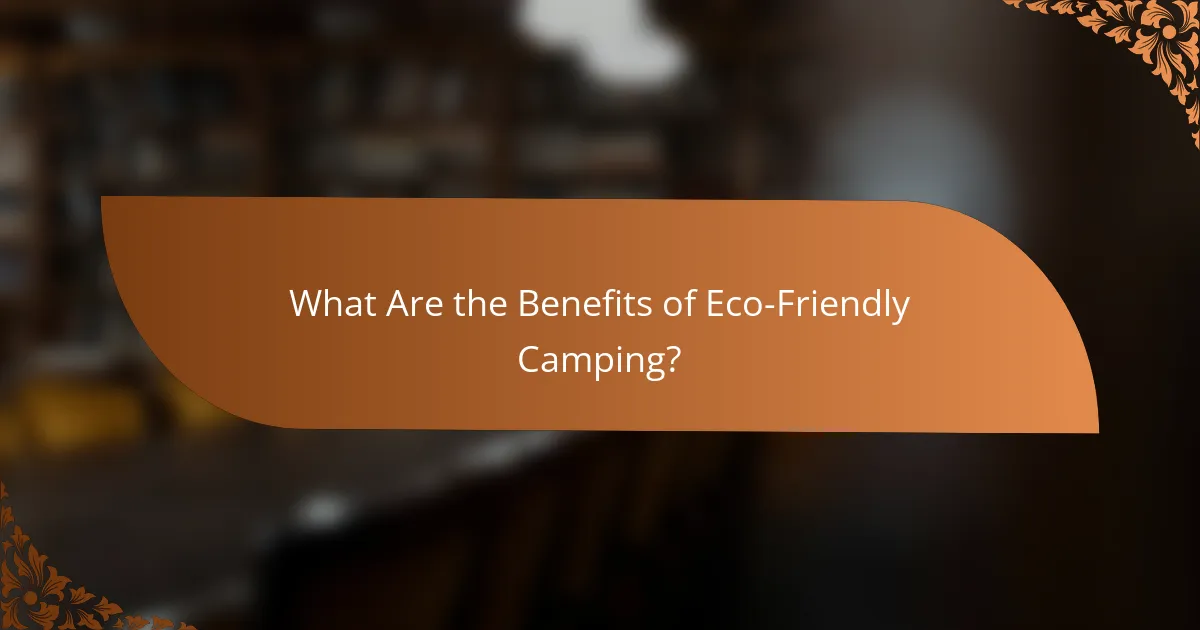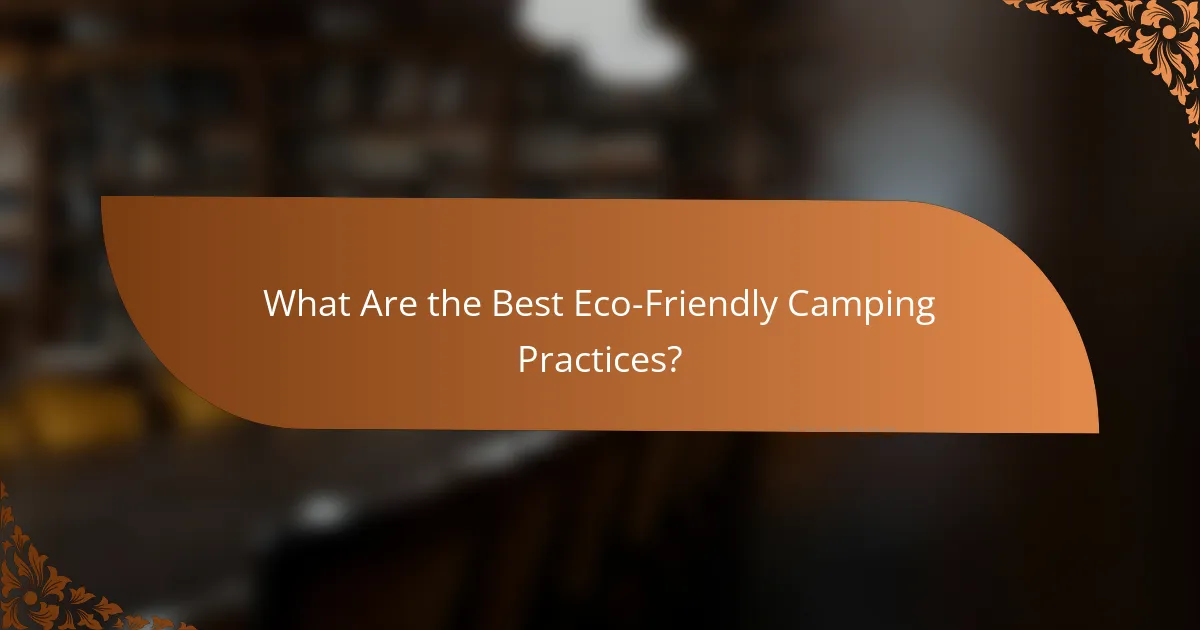Discover the best eco-friendly camping sites in national parks that emphasize sustainability and conservation while immersing you in the beauty of nature. These sites offer low-impact facilities and renewable energy sources, allowing you to enjoy the great outdoors while minimizing your environmental footprint. By choosing eco-friendly camping, you not only enhance your outdoor experience but also contribute to the preservation of our natural landscapes.

Where Are the Best Eco-Friendly Camping Sites in National Parks?
The best eco-friendly camping sites in national parks prioritize sustainability and conservation while providing access to nature. These sites often feature low-impact facilities, renewable energy sources, and practices that minimize environmental footprints.
Yosemite National Park
Yosemite National Park offers several eco-friendly camping options, including the popular North Pines Campground. This site utilizes solar power and has a strong commitment to waste reduction, encouraging visitors to practice Leave No Trace principles.
When camping in Yosemite, consider reserving a spot in advance, especially during peak seasons. The park’s stunning granite cliffs and diverse ecosystems make it an ideal location for nature enthusiasts.
Yellowstone National Park
Yellowstone National Park features eco-friendly campgrounds like the Fishing Bridge RV Park, which emphasizes sustainable practices. The park promotes recycling and has facilities designed to minimize energy consumption.
Visitors should be aware of wildlife regulations and practice safe camping techniques to protect both themselves and the environment. Booking early is advisable, as sites fill quickly during the summer months.
Great Smoky Mountains National Park
The Great Smoky Mountains National Park is home to several eco-conscious campgrounds, such as Elkmont Campground. These sites focus on preserving the natural landscape and offer educational programs about local ecology.
Campers should prepare for variable weather and bring eco-friendly supplies. The park’s rich biodiversity and scenic trails make it a prime destination for outdoor activities.
Joshua Tree National Park
Joshua Tree National Park features campgrounds like Hidden Valley, which promote minimal impact camping. The park encourages visitors to use established sites to protect fragile desert ecosystems.
Visitors should bring plenty of water and be prepared for extreme temperature changes. The unique rock formations and desert flora provide a stunning backdrop for camping and exploration.
Acadia National Park
Acadia National Park offers eco-friendly camping at sites like Blackwoods Campground, which emphasizes sustainability and conservation. The park has initiatives in place to reduce waste and promote natural resource protection.
Reservations are recommended, especially during the summer months. Acadia’s coastal views and diverse habitats make it a favorite for campers seeking both adventure and tranquility.

What Are the Benefits of Eco-Friendly Camping?
Eco-friendly camping offers numerous advantages, including reduced harm to natural environments and a more enriching outdoor experience. By prioritizing sustainability, campers can enjoy nature while actively contributing to its preservation.
Reduced environmental impact
Choosing eco-friendly camping practices minimizes pollution and habitat destruction. This includes using biodegradable products, adhering to Leave No Trace principles, and selecting campsites that are already established to avoid disturbing untouched areas.
Campers can further reduce their impact by using solar-powered equipment, packing out all waste, and opting for locally sourced food. These actions help maintain the integrity of ecosystems and preserve them for future generations.
Enhanced outdoor experience
Eco-friendly camping often leads to a deeper connection with nature. By engaging in sustainable practices, campers become more aware of their surroundings and the importance of conservation, enhancing their overall experience.
Activities such as wildlife observation, hiking on marked trails, and participating in local conservation projects can enrich a camping trip. These experiences foster a sense of responsibility and appreciation for the environment.
Support for local conservation efforts
Camping in eco-friendly ways often supports local conservation initiatives. Many parks and campsites invest a portion of fees into preserving natural habitats and wildlife, benefiting both the environment and the community.
By choosing eco-friendly camping sites, campers can directly contribute to these efforts. Look for parks that promote sustainability and offer programs aimed at protecting local flora and fauna, ensuring that your outdoor adventures help sustain the natural world.

How to Choose Eco-Friendly Camping Gear?
Choosing eco-friendly camping gear involves selecting products that minimize environmental impact while providing functionality and comfort. Focus on sustainability, energy efficiency, and versatility to ensure your camping experience is both enjoyable and responsible.
Look for sustainable materials
When selecting camping gear, prioritize items made from sustainable materials such as recycled plastics, organic cotton, and responsibly sourced wood. These materials reduce the ecological footprint and often come from manufacturers committed to environmental stewardship.
Check for certifications like Global Organic Textile Standard (GOTS) for textiles or Forest Stewardship Council (FSC) for wood products. These labels indicate adherence to strict environmental and social standards, ensuring that your gear supports sustainable practices.
Check for energy efficiency
Energy-efficient camping gear can significantly reduce your energy consumption while outdoors. Look for solar-powered lights, energy-efficient stoves, and appliances that consume less power, helping to minimize your reliance on fossil fuels.
Consider gear that utilizes rechargeable batteries or has low energy requirements. This not only benefits the environment but can also save you money on fuel and batteries over time.
Consider multi-use products
Multi-use camping products can help reduce the amount of gear you need, which in turn minimizes waste. Items like a camping stove that doubles as a grill or a backpack that converts into a sleeping bag can save space and resources.
When evaluating multi-use products, ensure they maintain quality and functionality for each intended use. This approach not only simplifies packing but also encourages a minimalist lifestyle, aligning with eco-friendly principles.

What Are the Best Eco-Friendly Camping Practices?
The best eco-friendly camping practices focus on minimizing environmental impact while enjoying nature. By adopting sustainable habits, campers can preserve natural habitats and ensure that outdoor spaces remain pristine for future generations.
Leave No Trace principles
Leave No Trace principles are guidelines designed to promote responsible outdoor ethics. These principles encourage campers to plan ahead, travel on durable surfaces, and dispose of waste properly to minimize their footprint on the environment.
Key practices include packing out all trash, respecting wildlife, and staying on marked trails. Following these guidelines helps to protect ecosystems and maintain the beauty of natural areas.
Use biodegradable products
Using biodegradable products is essential for reducing pollution in natural settings. Opt for items like biodegradable soap, utensils, and toiletries that break down naturally and do not harm the environment.
When selecting products, look for certifications or labels indicating biodegradability. This ensures that your camping gear and supplies will not contribute to long-term waste in parks and forests.
Minimize waste and recycling
Minimizing waste involves careful planning and conscious choices before and during your camping trip. Bring reusable containers, utensils, and bags to reduce single-use items, which can accumulate quickly in nature.
Additionally, familiarize yourself with local recycling options. Many national parks have specific guidelines for recycling, so check their websites or visitor centers for instructions on how to properly dispose of recyclable materials.

How to Plan an Eco-Friendly Camping Trip?
Planning an eco-friendly camping trip involves choosing sustainable practices that minimize your environmental impact. Focus on selecting green campsites, sourcing local food, and utilizing public transport to reach your destination.
Select a green campsite
Choosing a green campsite is essential for an eco-friendly camping experience. Look for sites that have received certifications for sustainability, such as Leave No Trace or Green Key. These campsites typically implement practices that protect local ecosystems and promote conservation.
Consider factors like proximity to natural resources, waste management systems, and the availability of eco-friendly amenities. Researching reviews and recommendations can help you identify campsites that prioritize environmental responsibility.
Plan meals with local ingredients
Planning meals with local ingredients reduces your carbon footprint and supports local economies. Visit farmers’ markets or local grocery stores near your campsite to find fresh produce and regional specialties. This not only enhances your meals but also connects you with the local culture.
When preparing your menu, aim for simple, minimal-waste recipes that require fewer packaged goods. Consider using reusable containers and utensils to further decrease waste while enjoying your outdoor culinary experience.
Use public transport to reach the site
Utilizing public transport to reach your camping site is a practical way to lessen your environmental impact. Buses, trains, and shuttles often have lower emissions per passenger compared to individual cars. Check local transit options and schedules to find the most convenient routes to your destination.
If public transport is not available, consider carpooling with fellow campers to minimize the number of vehicles on the road. This approach not only reduces emissions but also fosters a sense of community among campers.

What Are the Costs of Eco-Friendly Camping?
The costs of eco-friendly camping can vary widely based on location, amenities, and the specific national park. Generally, you can expect to pay for campsite fees, permits, and potential equipment rentals, which can range from modest to more significant amounts depending on your choices.
Camping fees in national parks
Camping fees in national parks typically range from around $15 to $50 per night, depending on the park and the type of site. Some parks offer primitive sites at lower rates, while developed campgrounds with amenities like restrooms and showers may charge more.
It’s essential to check each national park’s website for specific fee structures and any additional costs, such as entrance fees or reservation fees. Some parks may offer discounts for seniors, military personnel, or annual pass holders.
When planning your trip, consider the peak season, as prices can increase during busy months. Booking in advance can help secure lower rates and ensure availability in popular parks.
